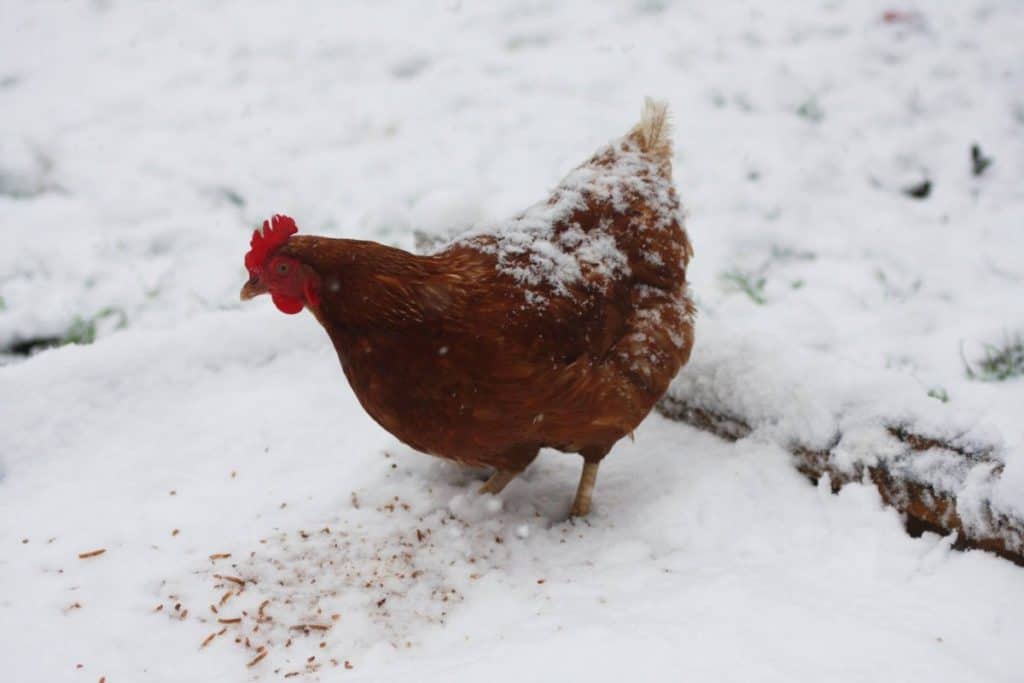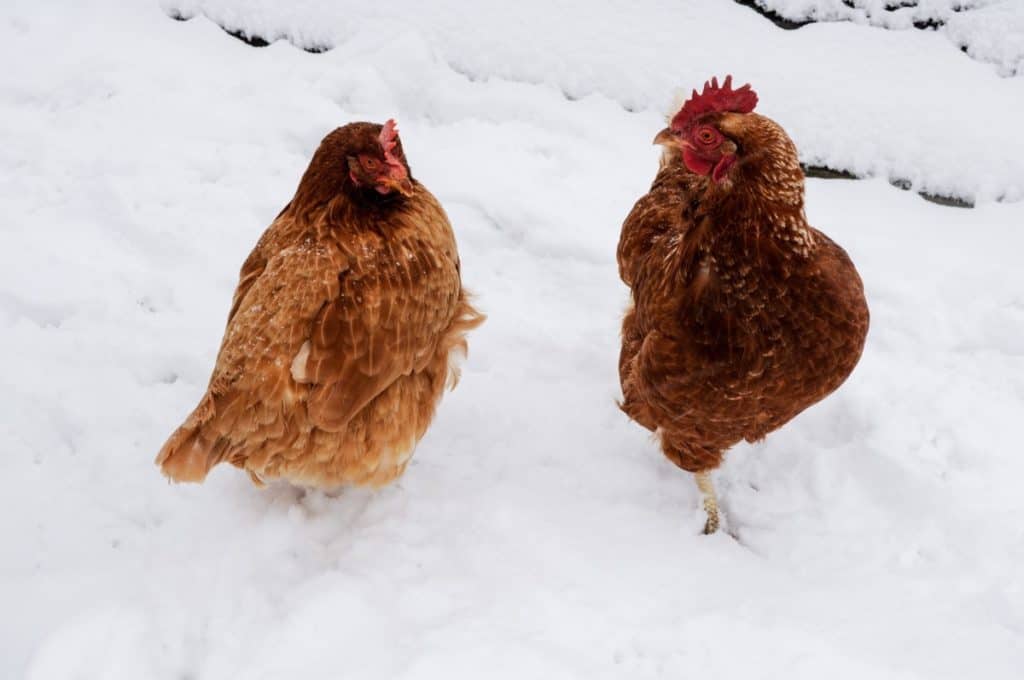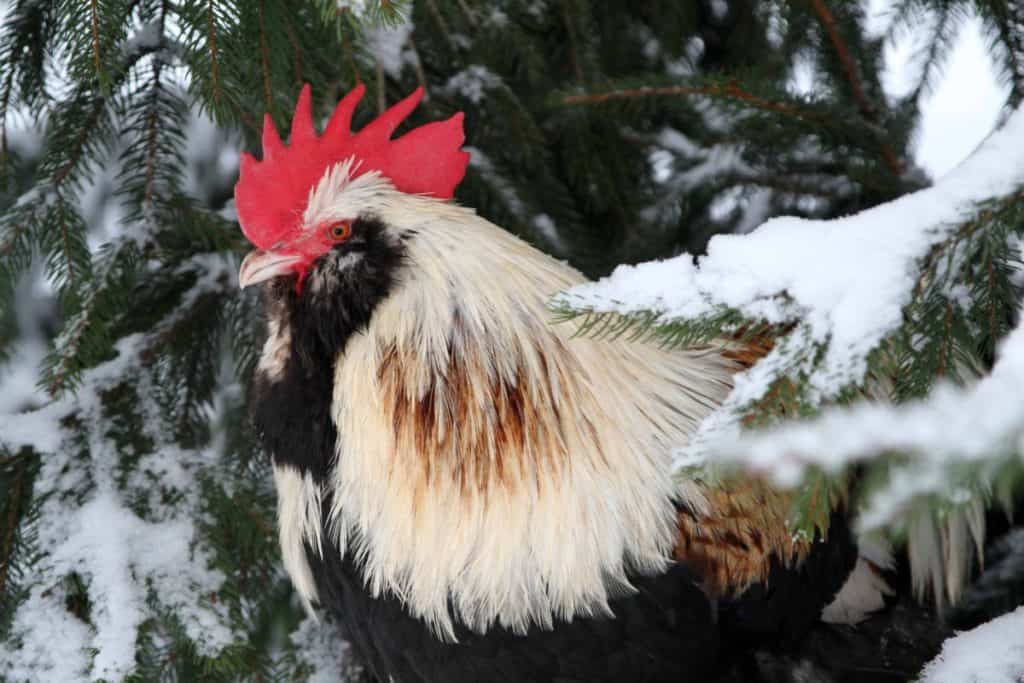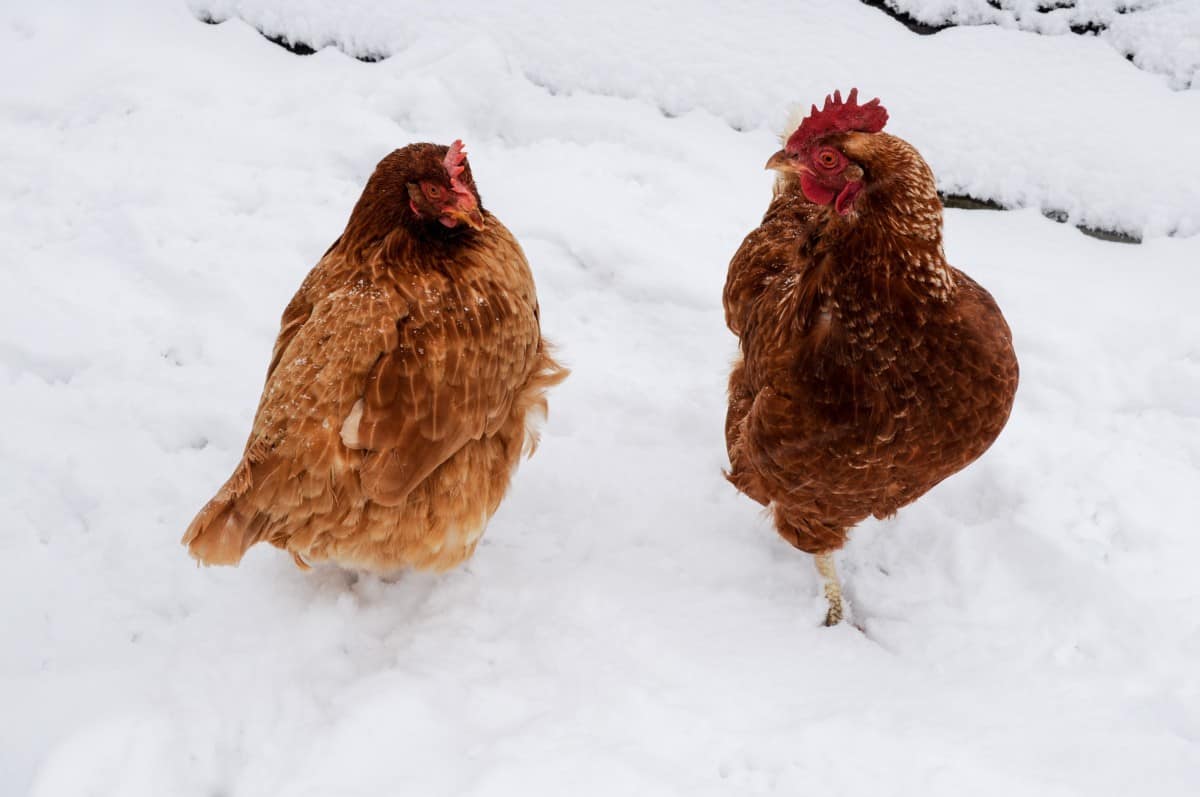
Do chicken feet get cold during the winter? This is a question I have often asked myself when temperatures plunge and water begins to freeze outside.
I don’t like the thought of my flock feeling discomfort because of the cold weather. So I decided to do some research and this is what I found.
Do chicken’s feet get cold? Yes, a chicken’s feet can get cold. Chickens feel the cold on their feet. Often when a chicken’s foot is too cold they will stand on one foot. At the same time, they will warm the other foot by keeping it close to their body. They will then alternate and raise up the other leg to warm it up.
If you have experienced snowfall clear out an area. Make a path to your chicken’s food and water that is free from the snow to reduce stress.
- How Can You Tell If A Chicken Is Cold?
- Do A Chickens Legs Get cold?
- Do Chickens Get Frost Bite?
- Are Hens Or Roosters at Greater Risk For Frostbite?
- Signs That Your Chickens Have Frostbite
- How Do Chickens Stay Warm During Winter?
- Do Chickens Need a Heat Lamp in The Winter?
- Should You Insulate a Chicken Coop?
- How Do I Keep My Chickens Warm In The Winter Without Electricity?
- Final Thoughts
How Can You Tell If A Chicken Is Cold?
Chickens are usually just fine in cold temperatures unless it gets below zero for an extended period of time. After all, chickens are birds and birds of many different species have survived thousands of years in cold temperatures around the world.
Signs of a chicken being cold include: fluffed up feathers, standing on one leg to warm up the other under its feathers and huddling with other chickens to stay warm.
A chicken that is feeling stressed from the cold will look cold. It may be huddled and not moving around much.
The chicken’s feathers may be fluffed up considerably and the chicken may stand on one leg, keeping the other tucked up in the belly feathers, for warmth.
If you live in a part of the world with very cold winters you will want to make sure your chicken coop is insulated. In climates that have temperatures that rarely drop below 15°F (-9.4°C) insulating a may not be necessary.
Chickens are much more tolerant with cold-weather temperatures compared to extremely hot ones.

Do A Chickens Legs Get cold?
Yes, a chicken’s lets can get cold. If a chicken stands still for too long their legs will start to get cold. By moving around a chicken will keep its legs warm.
A chicken has an average body temperature of 105.8°F (41°C). Chickens are warm-blooded just as all birds are.
One of the best ways for a chicken to keep its legs and feet warm is to perch.
When perching a chicken tucks its legs and feet under its warm body. This body heat keeps the chicken’s legs and feet warm.
This is why it is important for your coop and outdoor areas to contain a perch. Make a perch that is at least 4 inches in diameter. This way the chickens will not have to grip the perch with their feet when roosting. This will help reduce heat loss.
A 2×4 board works well for this and is cheap.
Do Chickens Get Frost Bite?
Yes, chickens get frostbite. Chickens get frostbite on parts of their body such as the wattles, comb, toes, feet, and legs. Chickens do not sweat. They control their body temperature with the help of their comb and wattles.
Chicken breeds with large combs and wattles are more susceptible to frostbite when compared to other breeds. Single comb breeds are more susceptible to frostbite and are better suited for warmer climates.
Feather-legged chicken breeds are also at more risk for frostbite than nonfeathered breeds. This is because mud, moisture, snow, or slush can get embedded in the feathers of their feet and freeze.
A chicken can also get frostbite when there is excess moisture in the air.
This excess moisture can settle on their wattles and comb due to poor ventilation in their coop causing frostbite.. Water that drips from their beaks onto their wattles can also cause frostbite in extremely cold weather.
Are Hens Or Roosters at Greater Risk For Frostbite?
Roosters are more susceptible to frostbite due to their larger wattles and comb. However, both can experience frostbit when temperatures drop below 32°F (0°C).
Signs That Your Chickens Have Frostbite
Eary signs of chicken frostbite
- Grayish or pale areas on the wattles or comb often seen on the edges.
- Toes or feet of the chicken are more reddish than usual
- Your chicken is lethargic or shows signs of being in pain
Later signs of chicken frostbite
- The tissue has turned black in appearance
- The chicken may start to limp or not walk in its usual manner
- Areas of the affected tissue start to swell and blister
- Hard or cold skin
How Do Chickens Stay Warm During Winter?
As with many types of birds, chickens trap air in between their feathers. This insulates them during the cold winter months and keeps them warm
Do Chickens Need a Heat Lamp in The Winter?
In most cases, chickens do not need a heat lamp during the winter. Chickens can regulate their body temperature and have a protective layer of feathers to keep their bodies warm.
If you live in a climate that gets very cold during the winter you should raise a cold-tolerant breed of chicken.
Should You Insulate a Chicken Coop?
Whether you need to insulate your coop will depend on the climate you live in. In climates that get below -10 °F insulating, a coop is a must. If you live in an area that rarely gets below freezing then insulation other than a thick bedding of wood shavings on the floor is not necessary.
A well-insulated coop will keep your chickens cool during the summer months and warm during the winter. It will also help keep them dry. Having a dry coop with little moisture is one of the keys to chickens withstanding cold weather.

How Do I Keep My Chickens Warm In The Winter Without Electricity?
1. Make sure your coop is dry
A dry coop will help keep your flock healthy. Wet damp coops are a recipe for disease and illness.
2. Eliminate any drafty areas in your coop.
Make sure you still have proper ventilation in your coop so that moisture can escape and not settle on your chicken’s wattles and comb.
3. Insulate your coop
If you live in a cold climate it is important to insulate your coop. This will keep your chickens warm during the cold nights and extreme cold. It will also keep your flock cool during the hot summer months.
4. Thick layer of bedding
A thick layer of bedding in your coop up to a foot in depth is one of the keys to keeping your coop warm. You should turn the bedding over at least once a week with a pitchfork.
5. Deep clean your coop before winter
Cleaning out bird droppings will keep moisture from building up in the air. Excess moisture in a coop can cause frostbite on your chicken’s wattles and comb during cold weather.
6. Keep your chickens well-fed
Chickens use more energy during the winter to stay warm. Chickens eat more food during winter to maintain the right amount of energy to accomplish this.
7. The right size roost
You want a roost that is atleast four inches wide. A 2X4 board works well for this.
Final Thoughts
Incorporate some of these ideas when preparing your chickens for the winter months and hopefully, you can avoid any problems that often come up in cold weather.
If your chicken is experiencing frostbite you make want to consult a veterinarian on the best remedy available.

